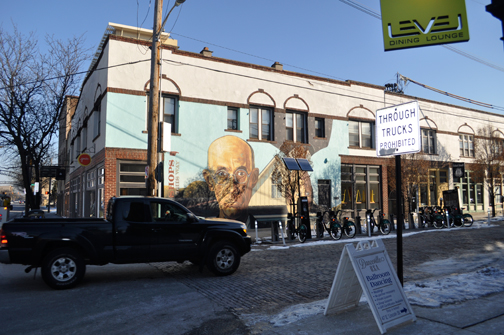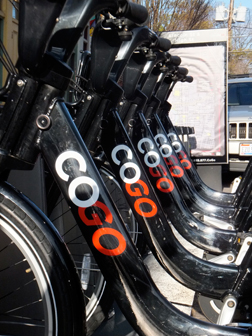
Columbus, Ohio USA
Return to Homepage www.shortnorth.com
CoGo Controversy
East Lincoln Street bike station troublesome to some business owners
By Tracy Zollinger Turner
tzt@writearm.com
March/April 2015 Issue
Return to Homepage / Return to Features Index
The East Lincoln Street bike share station in the Short North holds 13 bikes and was built onto the narrow two-way street,
absorbing a parking space, making driving more difficult at times, and distracting High Street pedestrians from a direct view of the storefronts behind it. Photo © Tracy Zollinger TurnerThe first 30 CoGo bike share stations were laid down around the city in the summer of 2013 with a lot of surrounding excitement about supplementing Columbus’ transit system with a new, green option. The rentable bikes came with a public fitness halo, plus the potential to offset some of the city’s long history of vehicle dependency and relieve some parking congestion in space-strapped neighborhoods.
But a few of the business owners who look out over the CoGo Station on East Lincoln Street in the Short North say that whatever the greater purpose of the system may be, the location creates a traffic problem, obstructs their business and is a potential safety hazard.
“This is the busiest side street in the Short North because of all of the viable businesses,” says Marcia Evans, owner of Marcia Evans Gallery. The bike station sits just outside of her door, and she has vocally opposed it since it was placed there, even gathering petition signatures that she took to the city, asking to have it moved a year ago. “Customers complain all the time. They will tell us ‘I don’t come down Lincoln anymore.’ When a truck is coming down, no one can get out of the way of the bikes. It’s become such a mess that people are starting to ignore our street – cars and pedestrians. They just avoid it.”
According to Motivate, the Brooklyn-based company that Columbus has contracted to manage and operate the CoGo system for five years, the Lincoln Street station is the second most popular in the city’s system. But there is disagreement over whether or not the businesses there can benefit from the bike share users, or whether the concerns of the Lincoln Street business owners outweigh the benefits other Short North business owners believe the system brings to their businesses, the neighborhood or the city.
“Nobody’s happy that it’s placed where it’s placed. I see people using it, but there are 14 bikes there, and I don’t see enough people to warrant it being that big… I see a lot of people walking up to it and looking at it and walking away. A lot of people in the Short North have their own bikes. I don’t see a whole lot of use of the system with patrons,” says Mark Haberman of Richard Bennett Clothiers. “I’ve had customers complain that we lost a parking meter, which makes it difficult to park. It’s kind of unsightly. It just seems that there are better places for it.”
One parking meter space was, in fact, absorbed when the station was placed, which holds 13 bikes. According to Brad Westoff of Columbus Recreation and Parks Department, nine to 11 of its docks are routinely filled with others left open for returns, and estimates say that number of bikes “roughly translates into five or six motor vehicles. ”
In one and a half bike seasons (April through November is considered one season), Westoff says there have been 80,000 rides, averaging 300-500 rides per day city-wide. The city anticipates that number will go up to 1,000 per day this year, as there are eight new stations to be added that include locations at Fourth and High, in Victorian Village, Harrison West, Weinland Park and South Campus. The Ohio State University is also currently looking into opening its own bike share system, which, if compatible with the CoGo system, would even further broaden the spectrum of places in the city that bike riders would travel to and from.
“I think the biggest problem is the traffic pattern because when cars are trying to come down the street it creates a little bit of a traffic jam – someone has to wait to go in and out,” says Haberman. “During the evening hours with valet parking, people pull up, and when somebody else is leaving, it’s a real mess. During the day, big trucks come for the restaurants and it holds up traffic, especially during lunch hour and the evening.”
There is a “Through Trucks Prohibited” sign pertaining to Lincoln at the High Street intersection, but Marcia Evans also says that she sees people standing in the center of the street looking at the bikes, and that the station sits much too close to a fire hydrant.
Evans and others sat down with the city recently, a year after the initial petition was handed to the city, but there appears to be some misunderstanding about where the Columbus officials now stand on the issue of the Lincoln Street station’s future.
“When they came to us with their concerns, they didn’t just come saying ‘we don’t like it,’” says Leslie Strader, assistant environmental steward for the City of Columbus. “They came with safety issues, so it was very important that we look at those and we did that.”
Among the measures the city took, says Strader, was to have a police officer observe the pedestrian and auto traffic during Gallery Hop, to have the fire department assess whether the hydrant is in fact too close to the station and another traffic engineer look at the site.
“I told them that at this time – none of the experts we had check those safety issues had concerns. And at this time, we don’t have another spot to move it to,” says Strader. “We have looked at alternative sites. We’re not opposed to moving it at all if there’s a better location.”
A less publicly measurable issue is whether or not the station, which is bounded by an advertising board, harms the businesses that sit directly behind it.
“Let’s say you’re giving a speech in front of a large audience and it’s an important speech and you’re on stage and there’s a guy in the corner of the stage who starts juggling,” says Paul Palnik, owner of Palnik Studios at 14 E. Lincoln. “Who are they looking at? They’re not physically blocking you, but who are they looking at? When people are walking down the street they have maybe ten seconds to look down and see what stores are there. When people cross the street here, they’re looking at the bikes.
“I would say my walk-in trade has dropped off 80 to 90 percent. It’s disastrous.”
Charly Bauer of Jeni’s Ice Cream, which has a location on the northeast corner of Lincoln and High, is an avid supporter of the CoGo program and intends to start using it himself this spring to get from Jeni’s new home office in the Arena District to appointments and lunches in the Short North.
“When I view that station there it feels more translucent than a car or an SUV,” he says. “If it’s the second most used station in town – if it’s working – why move it?
Kent Rigsby, who says he’s a big supporter of the initiative and keeps his own bike in his office for errands, had concerns when the bike station was first installed.
“My first reaction was that it was a funny location. I was skeptical about it being on Lincoln because the street doesn’t seem to be real wide. It hasn’t seemed to be a problem,” he says, noting that his location around the corner may limit his perspective. “I do think it’s aesthetically pleasing and adds to the notion of a pedestrian neighborhood.”
The owners of Level Dining Lounge, which sits on the southeast corner of Lincoln and runs the valet across the street from the station, did not return phone calls.
Josh Quinn of High Street business Tigertree has long felt strongly enough that bike sharing is good for business in the Short North that he organized his own business-run bike sharing system with a few other merchants in 2008. Each organization bought a couple of bikes and allowed them to be checked out for a couple of hours for neighborhood use. He’s a strong supporter of the city-wide system.
“I was surprised when I heard that anyone had a problem with that station,” he says. “Anybody who rides a bike in the city knows how much it changes your perspective. You see things you wouldn’t ordinarily see from a car. You’re more vulnerable, you slow down and really take a look at what’s around you. It’s a great way to explore an urban core.”
“I’d like to throw my hat in the ring to have it moved here if they are going to move it,” he says. “I think it would be great for business.”
Motivate, the company that manages the CoGo system, also manages bike sharing programs in Washington, D.C., Chicago, New York City and other areas. They work under a five-year contract with the city, which owns the equipment, to maintain and fix the bikes and stations, and they work with Orange Barrel for the advertising on the bikes and stations. Revenues are used to support the system, which, according to Westall, “tend to be cost-heavy in the first two to three years of operation.”
“They [bike stations] can generate foot traffic,” says Dani Simmons, Motivate’s director of communications and external affairs. “Bike shares are not station to station or stop to stop like a bus stop or subway. They are point to point. When a person docks a bike, they are looking around to go to stores in that area… and when parking is tight, a person might not go there otherwise.”
According to Simmons, different cities use bike sharing differently. In New York, a greater number might use them to commute to work. Columbus officials say that the CoGo is most popular on the weekends.
“Our system seems to get the highest usage during leisure hours,” says Strader. “CoGo users are looking for shopping and riding, enjoying neighborhoods. That’s what our usage suggests right now.”COULD THE STATION BE MOVED?
Photo © Gus Brunsman III “The Alliance is sensitive to the concerns of all of our businesses,” says Betsy Pandora, executive director of the Short North Alliance. “We’ve been in conversation with the city and we’ve asked if they can explore all alternatives for a better nearby location.
“But, hands down, we feel that CoGo needs to be in the Short North. More globally, you look at the cities that Columbus benchmarks itself against and they all have this. People expect us to have something like this… it’s important to who we are as a forward-thinking community.”
There may be some misunderstanding between the Lincoln Street businesses and the city about how easily a move can be accomplished and still be effective for the CoGo system.
“Everywhere you look downtown the stations are against a wall, against a parking lot,” says Evans. “They aren’t in the middle of a busy street. There are plenty of locations.”
But according to Westoff and Strader, while the stations themselves are portable and not that difficult or expensive to move, finding locations that meet the needs for space and public access proved problematic in the Short North from the beginning.
Before the stations were placed, Westoff says that the city worked with the Short North Alliance and Italian and Victorian Village Commissions to seek out locations.
“We looked at many different spots – it’s not easy,” says Westoff. “There are places where the sidewalks are narrow and it interfered with walking traffic, or where the bikes wouldn’t be visible and usable for the public. It’s got to be someplace where people can find it and get to and from the station. Generally speaking, every few blocks should have a station to maximize access to the bikeshare network. The denser it is, the more often people use it.”
Among the relocation ideas that Lincoln Street business owners suggested was the bike rack on the west side of High Street that bounds the parking lot.
“That particular spot would have been great had the bike parking not already been there,” says Strader. The city explored it and found that the concrete foundation and existing structures that would have to be excavated to move the station and fit it there would be too expensive: “The estimate to move it there was tens of thousands of dollars.”
A space at Bollinger Tower was explored, but the size of the station impeded a walkway there. Looking for a spot on Buttles near High, which is a much wider street with wider sidewalks, “is a strong idea, and one we are looking into,” says Strader. Throughout the Short North, space is tight, “they are even having trouble finding spaces for public art right now.”
“There’s going to be some streetscaping in the area,” she says. “Some of those may create potential opportunities. By all means, if another spot appears that makes sense and it makes everyone happy, we will move it.”
This article was reported with support form Puffin Foundation West, Ltd. © 2015 Short North Gazette, Columbus, Ohio. All rights reserved.
Return to Homepage www.shortnorth.com


